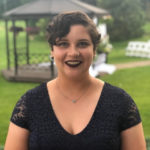NNA2 wants to know: How sturdy is YOUR skeleton?!!? No idea? Well, chemistry grad student Isabel Colón-Bernal will help clue you in. Assistant professor of Slavic languages and literatures Ania Aizman will be introducing us to anarchy and if you’re wondering where we could possibly be going next, neuroscience grad student Sharena Rice will be our guide through the labyrinth of brain functions that results in navigation. It’s going to be nerdy, it’s going to be night, it’s going to be all the things you ever dreamed Nerd Nite A2 could be! Hope you can join us for another great NNA2.
When: Thursday, 2/21/19
Doors at 6:30/talks at 7 pm
Where: LIVE, 102 S. First St
Cost: $0, I know, what a deal, right?
 Sharena Rice – A Brief History of [Inner] Space: Understanding the Brain’s GPS
Sharena Rice – A Brief History of [Inner] Space: Understanding the Brain’s GPS
Where are we? How do we know it? Where are we going? In this talk, I will discuss how the three-pound organ between our ears helps us find our way from point A to point B.
About Sharena: I am pursuing a Ph.D. in neuroscience and an MS in bioinformatics at the University of Michigan. Deep life conversations enthrall me. I can be found playing the electric saxophone in a Buddhist temple. My project uses virtual reality, robots, and lasers to understand how the brain navigates through space. Yes. I occasionally get lost.
Ania Aizman – Anarchism in Russia and the US
Nowadays anarchists are variously seen punching Nazis, setting police cars on fire, or offering free bike repair and starting community gardens. Is there a coherent set of ideas uniting these things? Is there a history to them? One way to tell the origin story of anarchism is to trace its emergence in Russia, from its successes and failures in the revolutionary movement against Tsarism to its persecution by the Soviet regime. Driven to exile, anarchists from Russia and Eastern Europe came to New York, helping to establish anarchist collectives across the United States.
About Ania: Like many people raised on Russian novels, I was drawn to radical ideas from an early age. But I walked into my first political demonstration by accident, and I practically stumbled on this topic (anarchism in Russia) as an academic, a researcher. There’s work to do to fill in the historical gaps, because no government — Tsarist, Soviet, or any other stripe — likes opposition to the state as such. Censorship and persecution have been with the anarchists from the beginning, but so have their various strategies of survival. Works of art and literature where radical ideas persisted are the focus of my research. I’m a member of the Michigan Society of Fellows and assistant professor of Slavic Languages and Literatures at U of M.
Isabel D. Colón-Bernal – The Chemistry that Backs Our Bones
Osteoporosis is a degenerative bone disease affecting about 75 million people worldwide. Recently, a link between what bones are made of, or composition, and how easily they break, or fracture risk, has been found. In addition, we know that composition is related to fracture risk, yet it has not been studied at the proper scale. In my research, I’m using AFM-IR to look at bone composition at ~50nm. I want to understand how bone composition at the nanoscale can affect a bone’s biomechanical properties at the macro scale. I want to see how bone composition can vary with disease and treatment. Understanding what bones are made of and how this changes their biomechanical properties will improve our understanding of osteoporosis, and how to treat it.
About Isabel: Isabel is a graduate student and scientific communications writing fellow in the Chemistry Department at the University of Michigan. As a member of the Banaszak Holl Lab, her research is on understanding the change in chemical composition of bones and microstructure of collagen as a function of disease and treatment, and how this relates to mechanical properties. She came to Michigan after graduating from her bachelor’s degree in Chemistry from the University of Puerto Rico Rio Piedras campus. Find her @BoriChemist.

